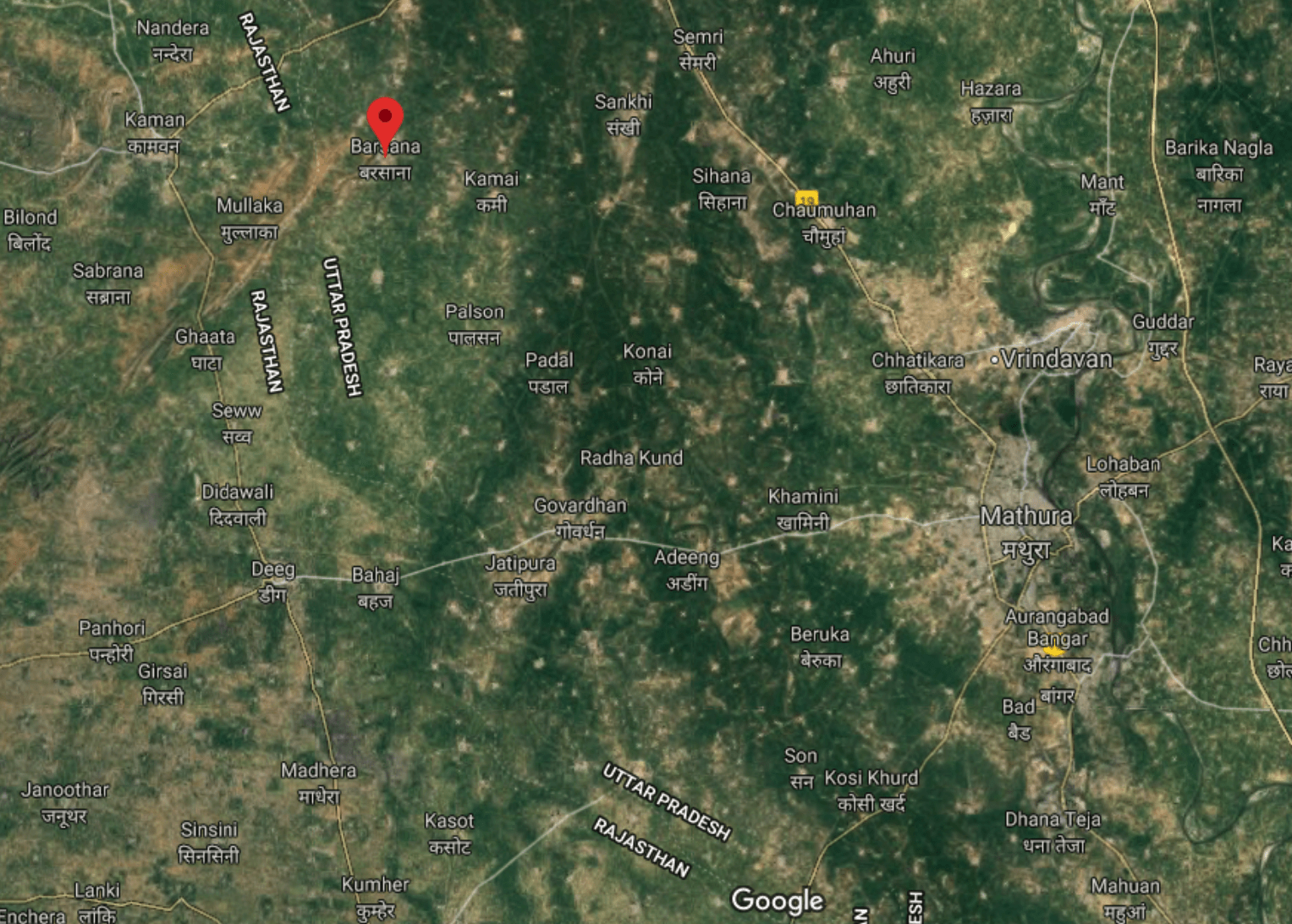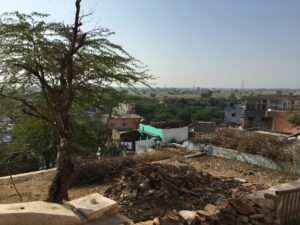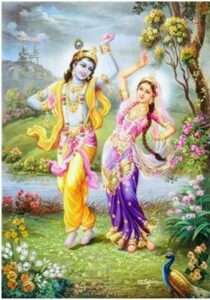 Brahmaji as a mountain in Barsana
Brahmaji as a mountain in Barsana
Lord Brahma is the father of all living beings in the universe. He lives for three hundred and eleven trillion (311,000,000,000,000) years and even the demigods turn to him in times of difficulty.
But Lord Brahma, according to Varaha Purana and Padma Purana performed tapasya, and prayed to Krishna to allow him to serve the Lord in such a way that the dust of the feet of not only the Lord but of all His devotees would always be upon his head. Understanding His devotee’s heart, Lord Krishna benedicted Brahmaji to become a mountain in Barsana Dham.
This mountain is comprised of two hills.
The white colored hill is the longer one and is called Brahma Hill while the black colored one is called Vishnu Hill.
The four peaks of this mountain in Barsana are actually the four heads of Brahmaji.
He finds greater pleasure with the devotees walking on the top of his head, sitting on his head, dancing on his head.
The peak where Vrishabhanu Maharaj had his palace is known as Bhanugarh.
Just across the ridge from Bhangadh, there is the beautiful peak that is called Vilasgarh, where Shri Shri Radha and Krishna performed innumerable playful pastimes.
The esoteric mountain peak where Shrimati Radharani would go in seclusion when She wanted to please Krishna through Her pastimes of ‘Anger’ is Maangarh.
The peak where the pastimes of charity and tax collection are performed is Daangadh.
Vilasgarh lies on the Vishnu Hill while the rest three lie on Brahma Hill.
A brief description of the important pastime places atop these four peaks can be given as follows:
Atop Bhanugarh is the famous temple of Shriji also called the Ladli Lal temple. On Bhanugarh, the palace of Vrishabhanu Maharaj is there where Shri Radhika performed Her childhood pastimes.
Across the road from Shriji temple is a beautiful pond called Pili Pokhar.
Atop Maangarh is the Maan Mandir, the place where Shrimati Radharani would go into seclusion in Her transcendental loving anger towards Krishna.
Down the hill from Maan Mandir are Morr Kutir and Krishna Kund.
Sankari Khor is a very narrow passageway at the junction of the Brahma hill and Vishnu hill where mischievous Krishna and His cowherd boys would stop Radharani and Her Sakhis and collect taxes of butter, yougurt and ghee from them.
Thus, Brahmaji in the form of this mountain is witness to these sweet pastimes in Varsana.
Varsana
Varsana is the pastime place of Sri Krishna’s beloved Srimati Radharani. Lying at the heart of this village is a multitude of the Divine Couple’s sweet and secret amorous pastimes, together with Their transcendental moods and desires.
The Vaishnava community reveres Varsana. This venerable land with its lakes, ponds, gardens and forests – such as Gahvaravana, Sankari Khor and other pastime places – reminds one of Radha and Krishna’s different pastimes.
In Vraja, the grass, small shrubs, creepers, trees, animals, birds, insects, snakes and so forth are all composed of sac-cid-ananda; or eternality, spiritual consciousness and full transcendental bliss. They assist Radha and Krishna in Their pastimes, and are very dear to Them.
It is said in the scriptures that even eminent realised souls, like Brahma and Sankara, repeatedly pray to attain a birth like theirs so that they too may be able to serve Radha and Krishna.
For instance, Srila Raghunatha dasa Gosvami says in Sri Vraja- vilasa-stava (verse 102):
yat kincit trina-gulma-kikata-mukham goshthe samasta hi tat sarvanandamaya mukunda-dayitam lilanukulam param
sastrair eva muhur muhuh sphutam idam nishtankitam yancaya brahmader api sa-sprihena tad idam maya vandyate
“All the grass, shrubs, insects and other creatures found in Vraja are very dear to He who is the very embodiment of all transcendental bliss, Sri Mukunda, and they assist in His pastimes. All the scriptures have repeatedly established this fact, and devotees ranging from Brahma to Uddhava have expressed a desire to take birth in Vraja amongst these species. For these reasons, I worship all the creatures who reside in Vraja.”
Varsana’s original name is Vrishabhanupura. Vrishabhanu Maharaja, the father of Srimati Radhika, lived here with his family.
Varsana is situated fourteen miles west of Govardhana and six miles east of Kamyavana.
According to the Varaha and Padma Puranas, Brahma pleased Sri Hari at the end of Satya-yuga by performing arduous worship.
Brahma then asked for the following boon: “Please perform Your sweet pastimes with the vraja-gopis on my very form and allow me to behold these lilas. Please make my life blessed, by especially performing swing pastimes in the rainy season and by performing Holi in spring.”
Pleased with Brahma, Sri Hari instructed him,
“Go to Vrishabhanupura and take the form of a hill there. In that form you will be able to behold all Our sweet pastimes.”
And so it happened that Brahma assumed the form of a hill at this place in Vraja and fulfilled his cherished desire.
Pastime Places in the Area of Varsana
The parikrama of Varsana is four miles long. Vraja-bhakti- vilasa, quoting Padma Purana, describes the characteristics of Vrishabhanupura as follows:
“According to the Padma Purana, two hills face each other here – one is Vishnu-parvata and the other is Brahma-parvata.
Vishnu-parvata is on the left and Brahma-parvata is on the right.
On top of Brahma-parvata is a temple of Sri Radha-Krishna. Close by to the north, on the lower side of this hill, is the palace of Maharaja Vrishabhanu, where one can have darsana of Sri Vrishabhanu Maharaja, Srimati Kirtida Maharani, Sridama and Srimati Radhika. Nearby is a temple of Sri Lalita, in which one can have darsana of Radhika along with nine sakhis.
“Also on top of Brahma-parvata are Dana Mandira, the place of a swing (hindola), Mayura-kuti, a rasa-mandala and a temple of Srimati Radha. Further on between the two hills is Sankari-khor. Near Sankari-khor is Vilasa Mandira, and next to Vilasa Mandira is Gahvaravana. Within Gahvaravana are Radha-sarovara and a rasa-mandala, and nearby is Dohani-kunda. Very close to this kunda is Mayura-sarovara, which was constructed by Citralekha.”
Bhanu-sarovara is also nearby, and on its bank is Vrajesvara, a deity of Maharudra. On its left side is Kirti-sarovara.
There are four sarovaras, or ponds, around Varsana:
(1) Vrishabhanu-kunda in the east,
(2) Kirtida-kunda in the north-east,
(3) Vihara-kunda (later named Tilaka-kunda) in the south-west, and
(4) Dohani-kunda in the south, south-west of the village of Ciksauli.
Sankari-khor lies north of Ciksauli, and on Vishnu-parvata, east of Sankari-khor, is Vilasa-garh. This is the location of a rasa- mandala.
Near Vilasa Mandira is where Radhika, as a child, played with the sand, building palaces and so on.
West of Sankari-khor, on top of the mountain, is Dana-garh; and south-west of Sankari-khor and west of the village of Ciksauli are Gahvaravana and Gahvara- kunda.
Mayura-kuti is to the right when entering Gahvaravana. On the top of the hill, south-west of Gahvaravana, are Mana-garh and Mana Mandira; and below and nearby is the village of Manapura.
North of Mana-garh is the temple of the Maharaja of Jaipura, and north of that temple is Sriji Temple.
Just below Sriji Temple, still on the hill, one comes to the temple of Brahmaji and the palace of Srimati Radhika’s paternal grandfather, Mahibhanu. Below that lies the village of Varsana. West of Varsana is Mukta-kunda, or Ratna-kunda.
Among the places listed above, we will describe those where prominent pastimes took place.
Varsana, more notes
Situated high on a hilltop that overlooks Varsana is the majestically beautiful temple known as the Shriji Mandira.
This is one of the most famous temples in Vraja and was built on the spot where Radharani once lived in Her father’s palace.
The temple is also called the Ladliji as well as Larilylal Mandira.
The village of Varsana is the place where Radharani spent the early part of Her youth, prior to Her marriage with Abhimanyu.
Although She was originally born at Raval near Gokula, when Krishna’s father moved his kingdom from Gokula to Nandagrama due to the fear of demons, his close friend Vrishabhanu Maharaja, Radha’s father, also moved his kingdom from Ravala to Varsana.
Nanda Maharaja and Vrishabhanu were both kings and rulers of the cowherd men, and both were extremely wealthy because they possessed thousands of cows and maintained large stocks of milk, butter, yogurt, ghee, as well as substantial stocks of grains.
They both built opulent and spacious palaces on the summit of hills and each palace was fully equipped with all the necessities and included many luxurious and palatial rooms where their respective families lived.
When Radharani arrived at Varsana she was around five years old and on the verge of entering Her ‘kaishori-lila’.
This is the period of her attaining youth-hood where she suddenly finds Herself being deeply attracted by the stunning beauty and lotus like eyes of Shri Krishna, who becomes not only the cynosure of Her eyes, but also the only purpose for which She seems exists.
Her arrival at Varsana also marks the start of the celebrated ‘gopi-lila’, and with the help of Her girlfriends the ashta-sakhis, She tries to capture Krishna’s heart through spontaneous acts of pure unadulterated love and devotion.
Every day Radharani wanders through the beautiful verdant forests of Vraja accompanied by Her girlfriends and together they enjoy innumerable transcendental pastimes in the company of Shri Krishna.
In the Bhakti-ratnakara it says.
“Here is Vrishabhanupura, also known as Varsana. Close to this mountain is the residence of Vrishabhanu. On this wonderful mountain the Prince of Vraja, Vrajendra-kumar, performs the dana-lila unseen by others. Here Radha’s proud pique was broken and where Krishna became intoxicated by performing so many wonderful pastimes.
Between the two mountains is a narrow path known as Sankara-khora or ‘Danagati’, and the fun that They had there is completely indescribable.
The dana-lila, mana-lila and vilasa-lila, all took place on the ridges of these two mountains.
Radharani played with Her girlfriends here in Her childhood.
In her adolescence she sported here with Her ‘sakhis’ and within the nipa groves the ‘sakhis’ glimpsed the incredible beauty of her full youth-hood”.
Besides being the ancestral home of Radharani, the Puranas say that Varsana is also mentioned as being one of the important upavanas or sub-forests of Vrindavana Dhama, where the transcendental pastimes between Radha and Krishna take place.
In recent times, Varsana has become internationally famous for the annual ‘Spring Festival’ known as the Holi-mela that is celebrated with great fervor by the local people, who throw large quantities of both colored powder and colored water on each other as part of the festivities. Also known as the ‘Festival of Colors’, it is celebrated all over India and is one of the country’s major religious festivals. Radha and Krishna also played holi with Their many sakhis and sakhas at various places around Vraja including Seva Kunja, Shyama Kuti, and Ganthuli Grama. It is believed that this festival has its origins in ancient Indian history, when the boy-saint Prahlada, a great devotee of Lord Vishnu, was saved from death when his demonic father King Hiranyakasipu, ordered Holika his sister, to burn Prahlada alive because of his unswerving faith in Vishnu, however Holika herself was burned to death and Prahlada was saved, and the citizens celebrated the event which was at that time called Holika-mela.
Post view 331 times




